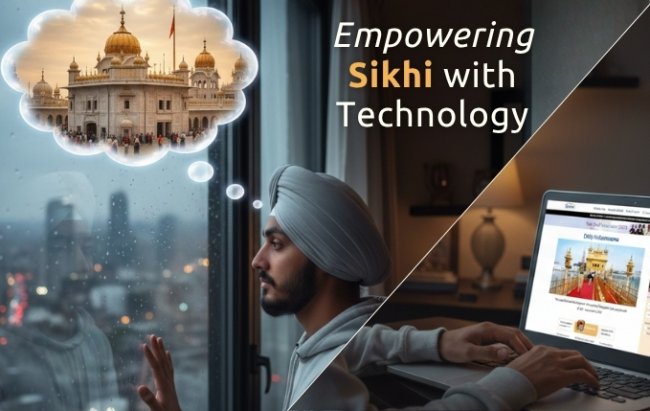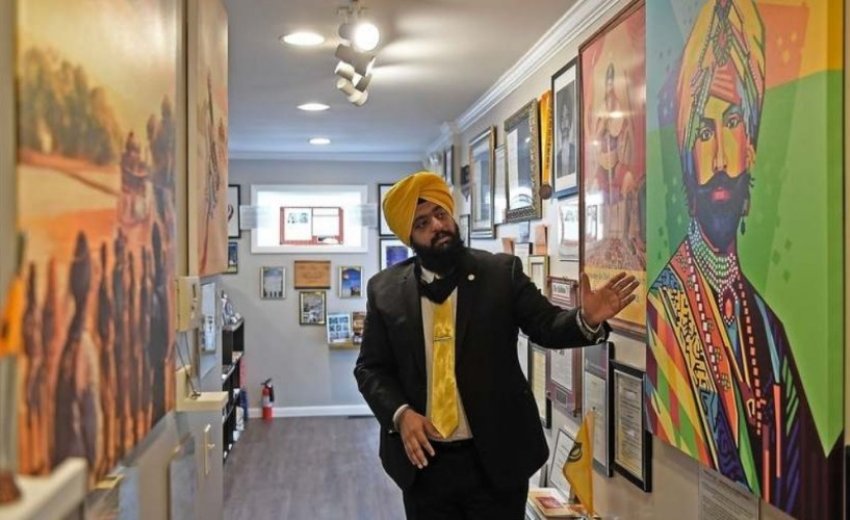The modest, single-storey structure is located on a commercially zoned street in Norwich, not far from Backus Hospital. It was once home to a dentist's office or a medical clinic. It houses the Sikh Art Gallery, and despite its somewhat small size, it contains a sizable collection of works by Sikh artists. As a young company, the gallery was a COVID-era work in progress in 2021.During the pandemic it was open to a limited number of visitors only by appointment.
A glimpse into the gallery
The gallery is also a welcome centre, and a library, and the owner, Swaranjit "Singh" Khalsa, uses it as his base to teach people in southeastern Connecticut about Sikh culture and history. Khalsa, on the other hand, says that not only did they want to introduce their community to the area, but also want to teach the Sikh community about Connecticut and America. He said, “This is our home now. We want to be good Sikhs and honour Punjab, but we want to be good Americans and honour America."
Khalsa, a member of The Day's new Diversity, Equality and Inclusion Advisory Board, cheerfully provides a fast tour of the gallery while wearing a dark suit, a yellow tie, and a matching turban, the traditional headdress worn by devout Sikhs that represents various values. When a visitor enters, there is a metal road sign that says the word WELCOME in 24 different languages, as well as a low-slung table with a variety of brochures, bumper stickers, and educational pamphlets about Sikhism and Punjab, the Indian state where the faith was founded and continues to be the spiritual home.
Khalsa's desk is located right beyond this, in front of a wall that is covered in a number of framed declarations and letters of appreciation from civic and cultural organisations welcoming the Sikh community to Norwich and Connecticut. Everywhere, vibrant Sikh flags are displayed, and there is a tonne of educational literature about Sikhism on the shelves.
In particular in this country after 9-11, when fear and misconceptions engulfed the Western world, Khalsa claims that religion is a profoundly misunderstood one. However, Sikhism is a universalist, egalitarian religion that was established in the 15th century in northern India by a young, high-caste Punjabi named Nanak after the realisation that all religions share the idea that God is formless and that racial, gender and class distinctions are unreal.
As on Sikh principle expresses it, "I see no stranger, I see no enemy, I look upon all with good will."
A vast spread of artefacts
Luminous ceremonial weapons, elaborate jewellery, and sculptures, including Lego models of Sikh architecture, are all on display. Khalsa adds, pointing to the Lego structure, that their goal is to engage people of all ages, starting with children. This is because young people have very open minds and are eager to learn new things.
The remaining walls in the main room and a small hallway are covered with scrolls, shields, paintings, and posters that represent early and native Hindu and Mughal court painting styles, the majority of which feature significant characters from Punjabi and/or Sikh history. The work is not constrained in a classicist sense, nevertheless. Several of them are drawn in a vibrant, post-modern manner and use artists from countries other than Punjab, such as Germany and Canada.
Also, there is a back courtyard that will be developed conceptually once the weather becomes better, according to Khalsa. A virtual tour of the exhibition was published online and the home page of the Sikh Art Gallery also includes links to well-known Sikh artists and art dealers.
None of the art that is currently on display in the gallery is for sale. In the future, Khalsa says, "Eventually, we will have travelling exhibits and show work by artists, some of whom will offer pieces for sale," The majority of the artwork on exhibit, however, is a resource for people who want to learn more about Sikhism as well as for schools or cultural groups who would like to see it.
Adding to it Khalsa says, "We needed a place to fully express ourselves on a variety of issues. I treat art and music and language as important opportunities to connect with one another. Art is something that brings an instant reaction or emotions, and we hope ours is in a positive way."
Norwich mayor Peter Nystrom, who has spoken at multiple events in support of the Sikh community and will make remarks in Hamden at an occasion honouring the Sikh flag and New Year on March 14, says that the gallery is filled with exquisite works of art and the colours are amazing, distinctive, and symbolic. He continues to say that the gallery displays Singh's commitment to his faith and his purpose, which is to connect everyone. It is more than just a venue to view art. He said that everyone needs to be aware of the challenges that Sikhs have encountered in the past and still face now.
A bit of history
According to Khalsa, the gallery is a dream that he first began to realise in 2010. With five houses of worship, the Sikh community is expanding not only in Norwich—where, according to him, 20 Sikh families currently reside—but also across the state.
He continues that he has worked for years to help break the ice, so to speak. In addition to his other work on behalf of the Sikh community, Khalsa—who also owns a Shell station in Norwichtown—played a key role in getting in establishing Nov. 30, 2018, as Sikh Genocide Remembrance Day in Connecticut.Thousands of Sikhs were slain 35 years ago in an attack by the Indian army for the installation of a memorial in their honour he also donated materials to Otis Library in 2019. However, the memorial was later pulled down, in part due to protests from the Indian government.
Understanding through art
Khalsa declares that they work to preserve our past, and if anyone has any questions, they are there to answer them. He says that these small efforts, along with this gallery, are helping them gain recognition . Also, everyone in Norwich has been incredibly friendly and accommodating, including the locals, the government, the companies, the schools, and the libraries. Khalsa says that they were glad to offer the resources and artwork to NFA and other schools in the district in the hopes that they would be curious to learn more about Sikhism.
According to Angela Adams, executive director of the Greater Norwich Area Chamber of Commerce, "Singh has been a great partner not only to our local businesses but to our community as well. I look forward to learning more about the culture and ways the chamber can help support their mission and raise awareness about their religion."
Waving his arm about the gallery in a paternal gesture, Khalsa says that he has enormous expectations for this place in many respects.
*Based on an article by Rick Koster, published in The Day on 27th February 2021

